Financial Resources and Decision-Making Report - Business Project
VerifiedAdded on 2020/01/07
|18
|4360
|493
Report
AI Summary
This report provides a comprehensive analysis of managing financial resources and decision-making, crucial for business projects. It begins by identifying various sources of finance, differentiating between short-term and long-term options like trade credit, bank overdrafts, bank loans, and issuing stock certificates. The report then assesses the implications of each source, considering legal aspects, costs, and suitability. It recommends bank loans as the most appropriate source for raising capital, highlighting their advantages in terms of repayment flexibility and lower interest rates. The report further emphasizes the importance of financial planning, detailing its benefits in maintaining cash flow balance, forecasting sales, coordinating activities, and optimizing resource utilization. It also outlines the information required by different decision-makers, including investors, directors, legal authorities, employees, and distributors. The analysis extends to the impact of financing sources on financial statements and includes a detailed cash budget analysis, assessing the viability of a project using investment appraisal techniques, and comparing financial ratios of different companies. This report provides a detailed overview of financial management, essential for understanding and making informed financial decisions.
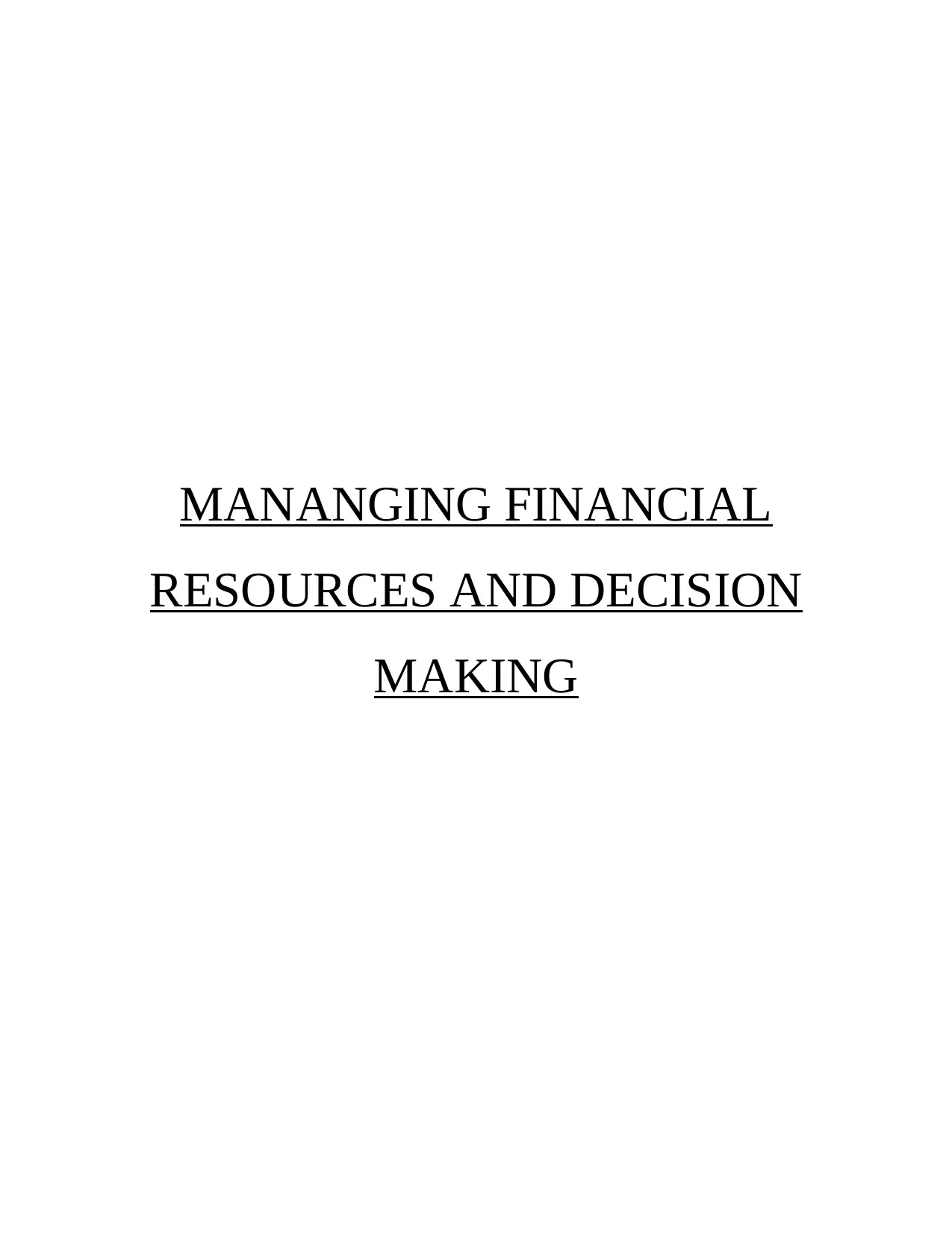
MANANGING FINANCIAL
RESOURCES AND DECISION
MAKING
RESOURCES AND DECISION
MAKING
Paraphrase This Document
Need a fresh take? Get an instant paraphrase of this document with our AI Paraphraser
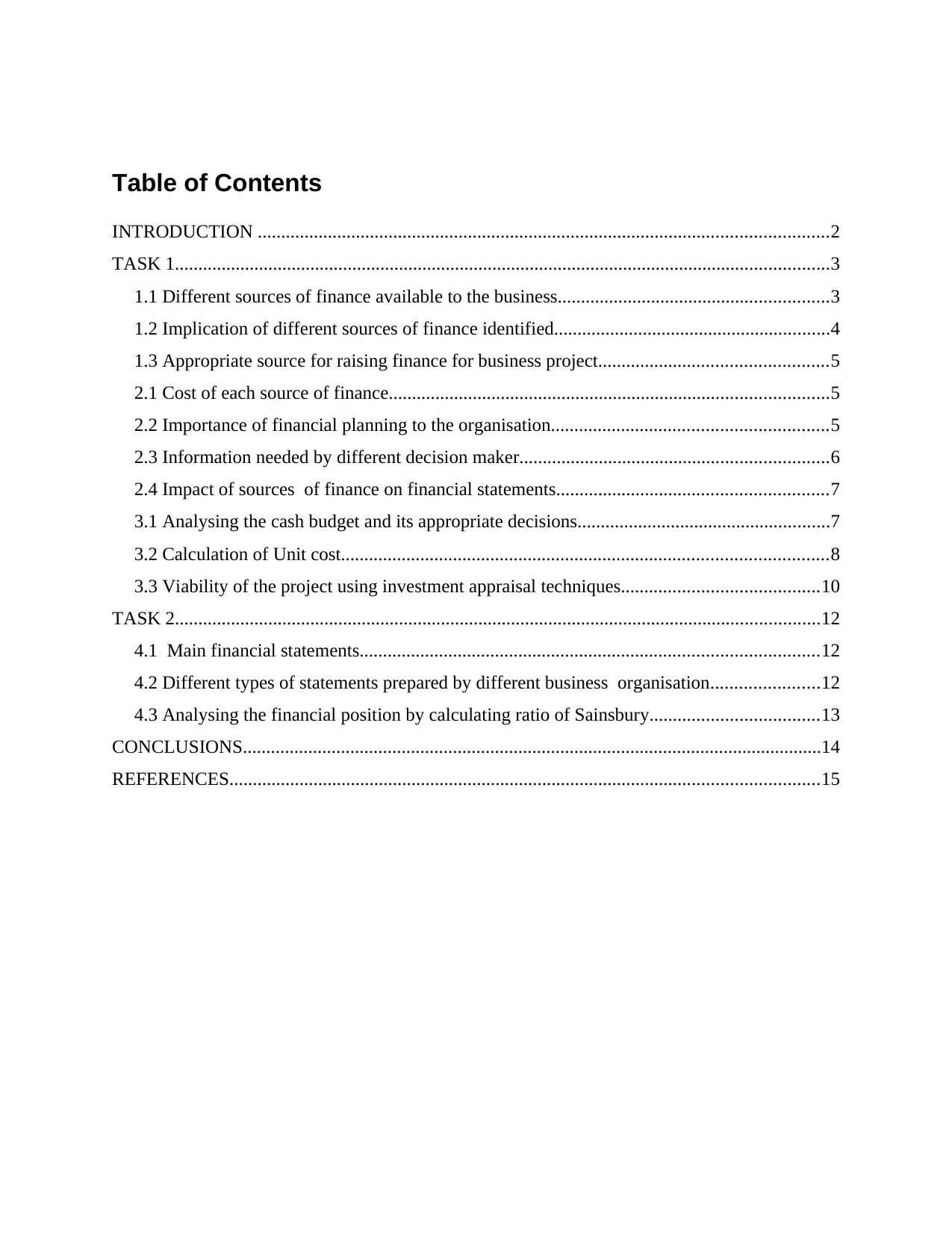
Table of Contents
INTRODUCTION ..........................................................................................................................2
TASK 1............................................................................................................................................3
1.1 Different sources of finance available to the business..........................................................3
1.2 Implication of different sources of finance identified...........................................................4
1.3 Appropriate source for raising finance for business project.................................................5
2.1 Cost of each source of finance..............................................................................................5
2.2 Importance of financial planning to the organisation...........................................................5
2.3 Information needed by different decision maker..................................................................6
2.4 Impact of sources of finance on financial statements..........................................................7
3.1 Analysing the cash budget and its appropriate decisions......................................................7
3.2 Calculation of Unit cost........................................................................................................8
3.3 Viability of the project using investment appraisal techniques..........................................10
TASK 2..........................................................................................................................................12
4.1 Main financial statements..................................................................................................12
4.2 Different types of statements prepared by different business organisation.......................12
4.3 Analysing the financial position by calculating ratio of Sainsbury....................................13
CONCLUSIONS............................................................................................................................14
REFERENCES..............................................................................................................................15
INTRODUCTION ..........................................................................................................................2
TASK 1............................................................................................................................................3
1.1 Different sources of finance available to the business..........................................................3
1.2 Implication of different sources of finance identified...........................................................4
1.3 Appropriate source for raising finance for business project.................................................5
2.1 Cost of each source of finance..............................................................................................5
2.2 Importance of financial planning to the organisation...........................................................5
2.3 Information needed by different decision maker..................................................................6
2.4 Impact of sources of finance on financial statements..........................................................7
3.1 Analysing the cash budget and its appropriate decisions......................................................7
3.2 Calculation of Unit cost........................................................................................................8
3.3 Viability of the project using investment appraisal techniques..........................................10
TASK 2..........................................................................................................................................12
4.1 Main financial statements..................................................................................................12
4.2 Different types of statements prepared by different business organisation.......................12
4.3 Analysing the financial position by calculating ratio of Sainsbury....................................13
CONCLUSIONS............................................................................................................................14
REFERENCES..............................................................................................................................15

2
⊘ This is a preview!⊘
Do you want full access?
Subscribe today to unlock all pages.

Trusted by 1+ million students worldwide
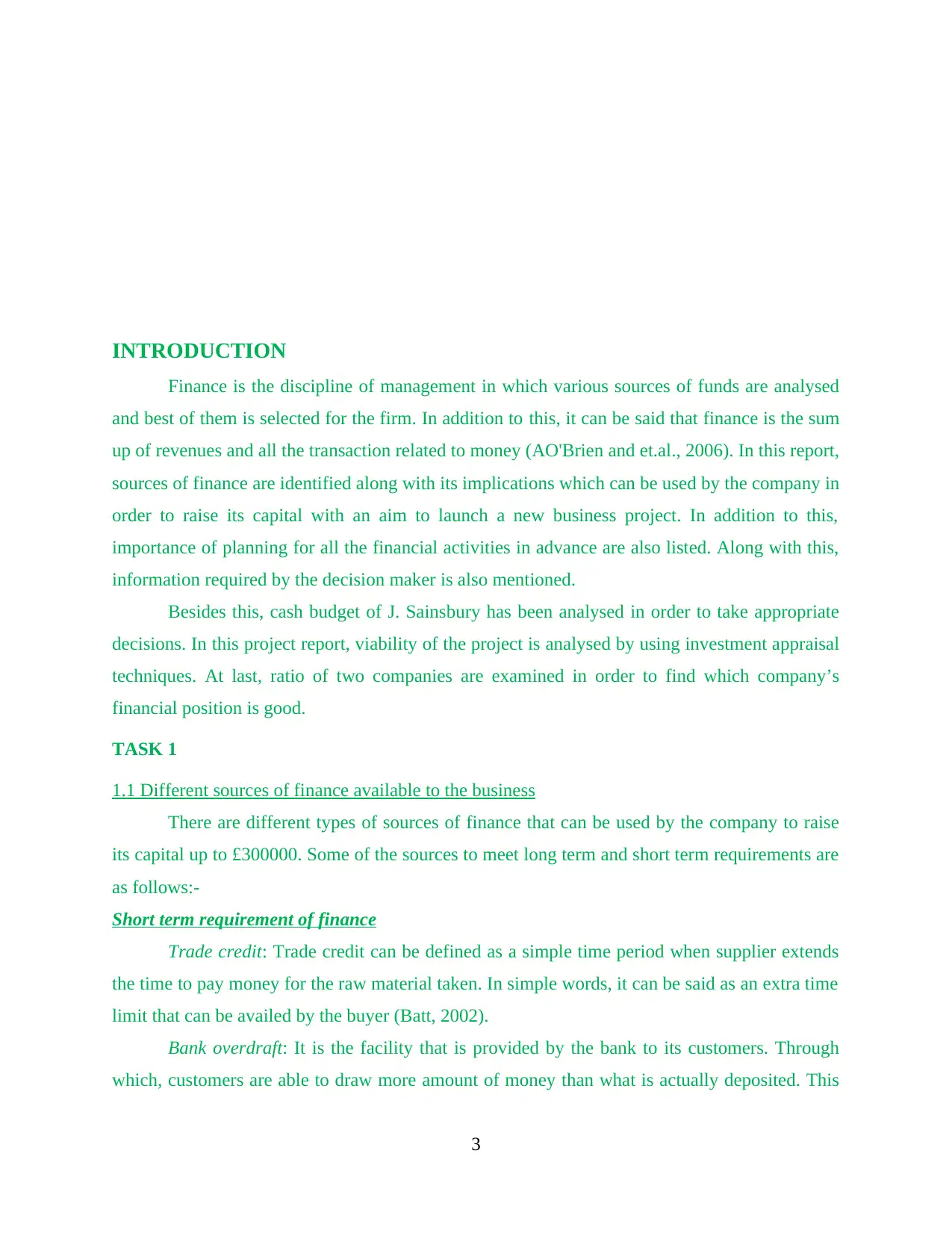
INTRODUCTION
Finance is the discipline of management in which various sources of funds are analysed
and best of them is selected for the firm. In addition to this, it can be said that finance is the sum
up of revenues and all the transaction related to money (AO'Brien and et.al., 2006). In this report,
sources of finance are identified along with its implications which can be used by the company in
order to raise its capital with an aim to launch a new business project. In addition to this,
importance of planning for all the financial activities in advance are also listed. Along with this,
information required by the decision maker is also mentioned.
Besides this, cash budget of J. Sainsbury has been analysed in order to take appropriate
decisions. In this project report, viability of the project is analysed by using investment appraisal
techniques. At last, ratio of two companies are examined in order to find which company’s
financial position is good.
TASK 1
1.1 Different sources of finance available to the business
There are different types of sources of finance that can be used by the company to raise
its capital up to £300000. Some of the sources to meet long term and short term requirements are
as follows:-
Short term requirement of finance
Trade credit: Trade credit can be defined as a simple time period when supplier extends
the time to pay money for the raw material taken. In simple words, it can be said as an extra time
limit that can be availed by the buyer (Batt, 2002).
Bank overdraft: It is the facility that is provided by the bank to its customers. Through
which, customers are able to draw more amount of money than what is actually deposited. This
3
Finance is the discipline of management in which various sources of funds are analysed
and best of them is selected for the firm. In addition to this, it can be said that finance is the sum
up of revenues and all the transaction related to money (AO'Brien and et.al., 2006). In this report,
sources of finance are identified along with its implications which can be used by the company in
order to raise its capital with an aim to launch a new business project. In addition to this,
importance of planning for all the financial activities in advance are also listed. Along with this,
information required by the decision maker is also mentioned.
Besides this, cash budget of J. Sainsbury has been analysed in order to take appropriate
decisions. In this project report, viability of the project is analysed by using investment appraisal
techniques. At last, ratio of two companies are examined in order to find which company’s
financial position is good.
TASK 1
1.1 Different sources of finance available to the business
There are different types of sources of finance that can be used by the company to raise
its capital up to £300000. Some of the sources to meet long term and short term requirements are
as follows:-
Short term requirement of finance
Trade credit: Trade credit can be defined as a simple time period when supplier extends
the time to pay money for the raw material taken. In simple words, it can be said as an extra time
limit that can be availed by the buyer (Batt, 2002).
Bank overdraft: It is the facility that is provided by the bank to its customers. Through
which, customers are able to draw more amount of money than what is actually deposited. This
3
Paraphrase This Document
Need a fresh take? Get an instant paraphrase of this document with our AI Paraphraser
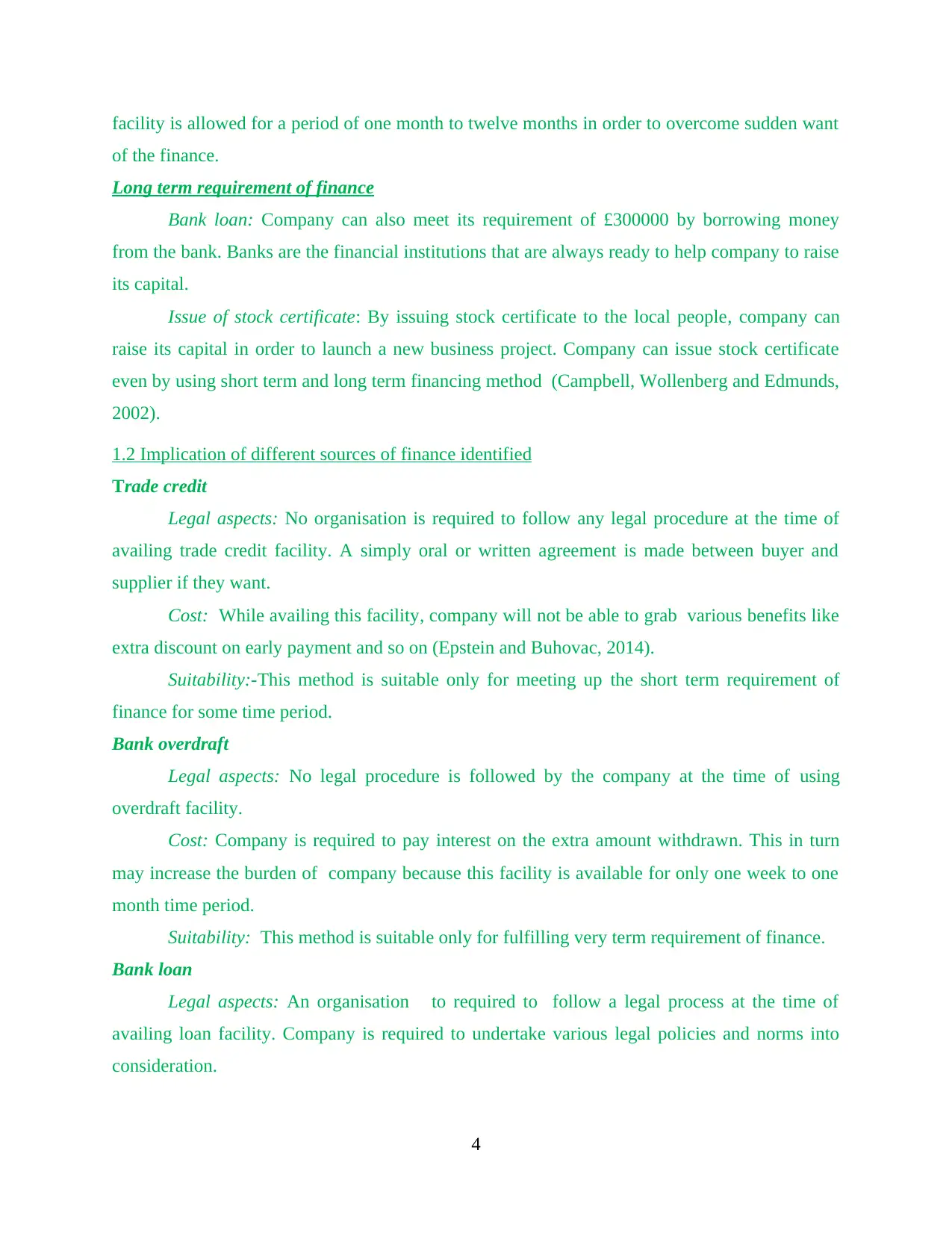
facility is allowed for a period of one month to twelve months in order to overcome sudden want
of the finance.
Long term requirement of finance
Bank loan: Company can also meet its requirement of £300000 by borrowing money
from the bank. Banks are the financial institutions that are always ready to help company to raise
its capital.
Issue of stock certificate: By issuing stock certificate to the local people, company can
raise its capital in order to launch a new business project. Company can issue stock certificate
even by using short term and long term financing method (Campbell, Wollenberg and Edmunds,
2002).
1.2 Implication of different sources of finance identified
Trade credit
Legal aspects: No organisation is required to follow any legal procedure at the time of
availing trade credit facility. A simply oral or written agreement is made between buyer and
supplier if they want.
Cost: While availing this facility, company will not be able to grab various benefits like
extra discount on early payment and so on (Epstein and Buhovac, 2014).
Suitability:-This method is suitable only for meeting up the short term requirement of
finance for some time period.
Bank overdraft
Legal aspects: No legal procedure is followed by the company at the time of using
overdraft facility.
Cost: Company is required to pay interest on the extra amount withdrawn. This in turn
may increase the burden of company because this facility is available for only one week to one
month time period.
Suitability: This method is suitable only for fulfilling very term requirement of finance.
Bank loan
Legal aspects: An organisation to required to follow a legal process at the time of
availing loan facility. Company is required to undertake various legal policies and norms into
consideration.
4
of the finance.
Long term requirement of finance
Bank loan: Company can also meet its requirement of £300000 by borrowing money
from the bank. Banks are the financial institutions that are always ready to help company to raise
its capital.
Issue of stock certificate: By issuing stock certificate to the local people, company can
raise its capital in order to launch a new business project. Company can issue stock certificate
even by using short term and long term financing method (Campbell, Wollenberg and Edmunds,
2002).
1.2 Implication of different sources of finance identified
Trade credit
Legal aspects: No organisation is required to follow any legal procedure at the time of
availing trade credit facility. A simply oral or written agreement is made between buyer and
supplier if they want.
Cost: While availing this facility, company will not be able to grab various benefits like
extra discount on early payment and so on (Epstein and Buhovac, 2014).
Suitability:-This method is suitable only for meeting up the short term requirement of
finance for some time period.
Bank overdraft
Legal aspects: No legal procedure is followed by the company at the time of using
overdraft facility.
Cost: Company is required to pay interest on the extra amount withdrawn. This in turn
may increase the burden of company because this facility is available for only one week to one
month time period.
Suitability: This method is suitable only for fulfilling very term requirement of finance.
Bank loan
Legal aspects: An organisation to required to follow a legal process at the time of
availing loan facility. Company is required to undertake various legal policies and norms into
consideration.
4
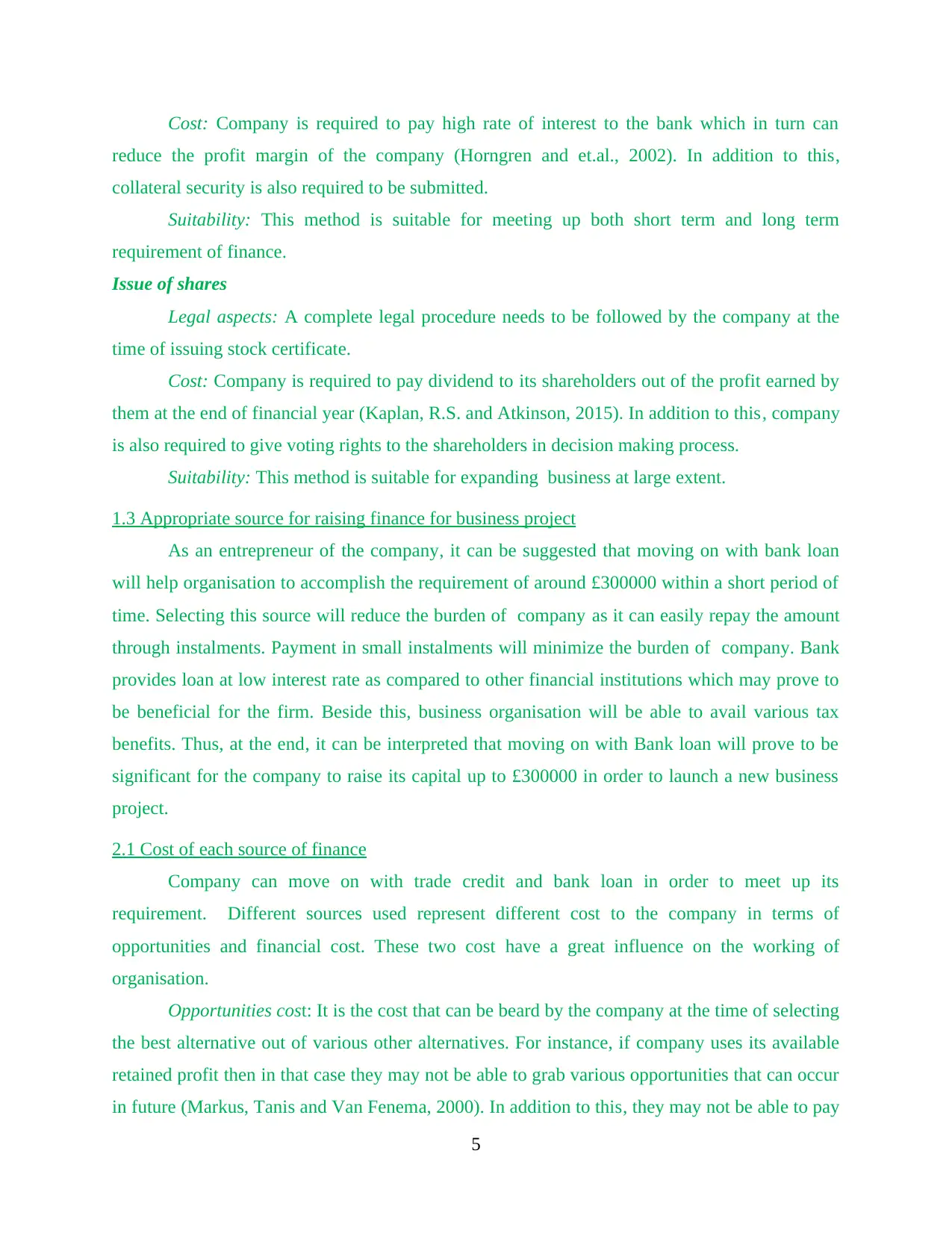
Cost: Company is required to pay high rate of interest to the bank which in turn can
reduce the profit margin of the company (Horngren and et.al., 2002). In addition to this,
collateral security is also required to be submitted.
Suitability: This method is suitable for meeting up both short term and long term
requirement of finance.
Issue of shares
Legal aspects: A complete legal procedure needs to be followed by the company at the
time of issuing stock certificate.
Cost: Company is required to pay dividend to its shareholders out of the profit earned by
them at the end of financial year (Kaplan, R.S. and Atkinson, 2015). In addition to this, company
is also required to give voting rights to the shareholders in decision making process.
Suitability: This method is suitable for expanding business at large extent.
1.3 Appropriate source for raising finance for business project
As an entrepreneur of the company, it can be suggested that moving on with bank loan
will help organisation to accomplish the requirement of around £300000 within a short period of
time. Selecting this source will reduce the burden of company as it can easily repay the amount
through instalments. Payment in small instalments will minimize the burden of company. Bank
provides loan at low interest rate as compared to other financial institutions which may prove to
be beneficial for the firm. Beside this, business organisation will be able to avail various tax
benefits. Thus, at the end, it can be interpreted that moving on with Bank loan will prove to be
significant for the company to raise its capital up to £300000 in order to launch a new business
project.
2.1 Cost of each source of finance
Company can move on with trade credit and bank loan in order to meet up its
requirement. Different sources used represent different cost to the company in terms of
opportunities and financial cost. These two cost have a great influence on the working of
organisation.
Opportunities cost: It is the cost that can be beard by the company at the time of selecting
the best alternative out of various other alternatives. For instance, if company uses its available
retained profit then in that case they may not be able to grab various opportunities that can occur
in future (Markus, Tanis and Van Fenema, 2000). In addition to this, they may not be able to pay
5
reduce the profit margin of the company (Horngren and et.al., 2002). In addition to this,
collateral security is also required to be submitted.
Suitability: This method is suitable for meeting up both short term and long term
requirement of finance.
Issue of shares
Legal aspects: A complete legal procedure needs to be followed by the company at the
time of issuing stock certificate.
Cost: Company is required to pay dividend to its shareholders out of the profit earned by
them at the end of financial year (Kaplan, R.S. and Atkinson, 2015). In addition to this, company
is also required to give voting rights to the shareholders in decision making process.
Suitability: This method is suitable for expanding business at large extent.
1.3 Appropriate source for raising finance for business project
As an entrepreneur of the company, it can be suggested that moving on with bank loan
will help organisation to accomplish the requirement of around £300000 within a short period of
time. Selecting this source will reduce the burden of company as it can easily repay the amount
through instalments. Payment in small instalments will minimize the burden of company. Bank
provides loan at low interest rate as compared to other financial institutions which may prove to
be beneficial for the firm. Beside this, business organisation will be able to avail various tax
benefits. Thus, at the end, it can be interpreted that moving on with Bank loan will prove to be
significant for the company to raise its capital up to £300000 in order to launch a new business
project.
2.1 Cost of each source of finance
Company can move on with trade credit and bank loan in order to meet up its
requirement. Different sources used represent different cost to the company in terms of
opportunities and financial cost. These two cost have a great influence on the working of
organisation.
Opportunities cost: It is the cost that can be beard by the company at the time of selecting
the best alternative out of various other alternatives. For instance, if company uses its available
retained profit then in that case they may not be able to grab various opportunities that can occur
in future (Markus, Tanis and Van Fenema, 2000). In addition to this, they may not be able to pay
5
⊘ This is a preview!⊘
Do you want full access?
Subscribe today to unlock all pages.

Trusted by 1+ million students worldwide
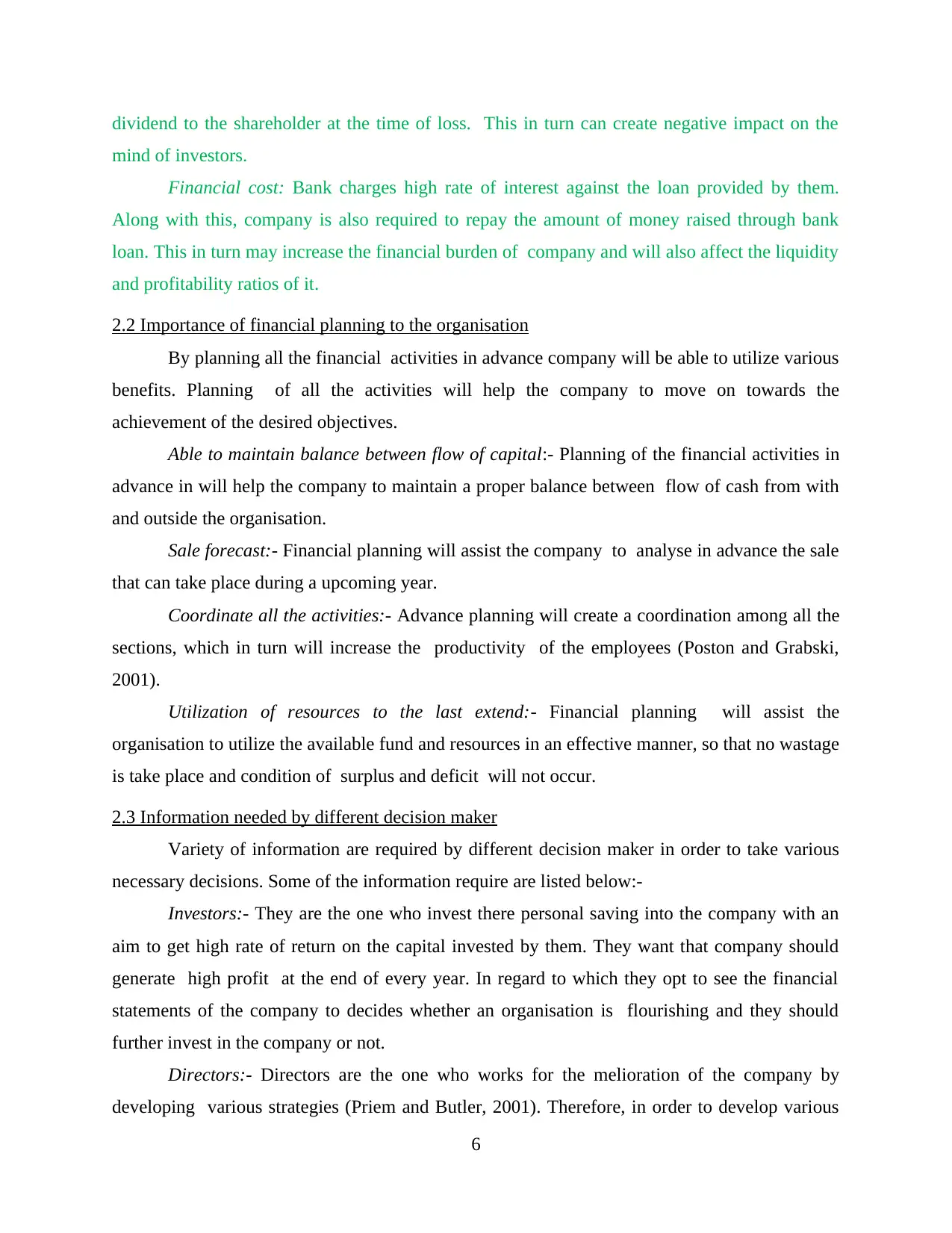
dividend to the shareholder at the time of loss. This in turn can create negative impact on the
mind of investors.
Financial cost: Bank charges high rate of interest against the loan provided by them.
Along with this, company is also required to repay the amount of money raised through bank
loan. This in turn may increase the financial burden of company and will also affect the liquidity
and profitability ratios of it.
2.2 Importance of financial planning to the organisation
By planning all the financial activities in advance company will be able to utilize various
benefits. Planning of all the activities will help the company to move on towards the
achievement of the desired objectives.
Able to maintain balance between flow of capital:- Planning of the financial activities in
advance in will help the company to maintain a proper balance between flow of cash from with
and outside the organisation.
Sale forecast:- Financial planning will assist the company to analyse in advance the sale
that can take place during a upcoming year.
Coordinate all the activities:- Advance planning will create a coordination among all the
sections, which in turn will increase the productivity of the employees (Poston and Grabski,
2001).
Utilization of resources to the last extend:- Financial planning will assist the
organisation to utilize the available fund and resources in an effective manner, so that no wastage
is take place and condition of surplus and deficit will not occur.
2.3 Information needed by different decision maker
Variety of information are required by different decision maker in order to take various
necessary decisions. Some of the information require are listed below:-
Investors:- They are the one who invest there personal saving into the company with an
aim to get high rate of return on the capital invested by them. They want that company should
generate high profit at the end of every year. In regard to which they opt to see the financial
statements of the company to decides whether an organisation is flourishing and they should
further invest in the company or not.
Directors:- Directors are the one who works for the melioration of the company by
developing various strategies (Priem and Butler, 2001). Therefore, in order to develop various
6
mind of investors.
Financial cost: Bank charges high rate of interest against the loan provided by them.
Along with this, company is also required to repay the amount of money raised through bank
loan. This in turn may increase the financial burden of company and will also affect the liquidity
and profitability ratios of it.
2.2 Importance of financial planning to the organisation
By planning all the financial activities in advance company will be able to utilize various
benefits. Planning of all the activities will help the company to move on towards the
achievement of the desired objectives.
Able to maintain balance between flow of capital:- Planning of the financial activities in
advance in will help the company to maintain a proper balance between flow of cash from with
and outside the organisation.
Sale forecast:- Financial planning will assist the company to analyse in advance the sale
that can take place during a upcoming year.
Coordinate all the activities:- Advance planning will create a coordination among all the
sections, which in turn will increase the productivity of the employees (Poston and Grabski,
2001).
Utilization of resources to the last extend:- Financial planning will assist the
organisation to utilize the available fund and resources in an effective manner, so that no wastage
is take place and condition of surplus and deficit will not occur.
2.3 Information needed by different decision maker
Variety of information are required by different decision maker in order to take various
necessary decisions. Some of the information require are listed below:-
Investors:- They are the one who invest there personal saving into the company with an
aim to get high rate of return on the capital invested by them. They want that company should
generate high profit at the end of every year. In regard to which they opt to see the financial
statements of the company to decides whether an organisation is flourishing and they should
further invest in the company or not.
Directors:- Directors are the one who works for the melioration of the company by
developing various strategies (Priem and Butler, 2001). Therefore, in order to develop various
6
Paraphrase This Document
Need a fresh take? Get an instant paraphrase of this document with our AI Paraphraser
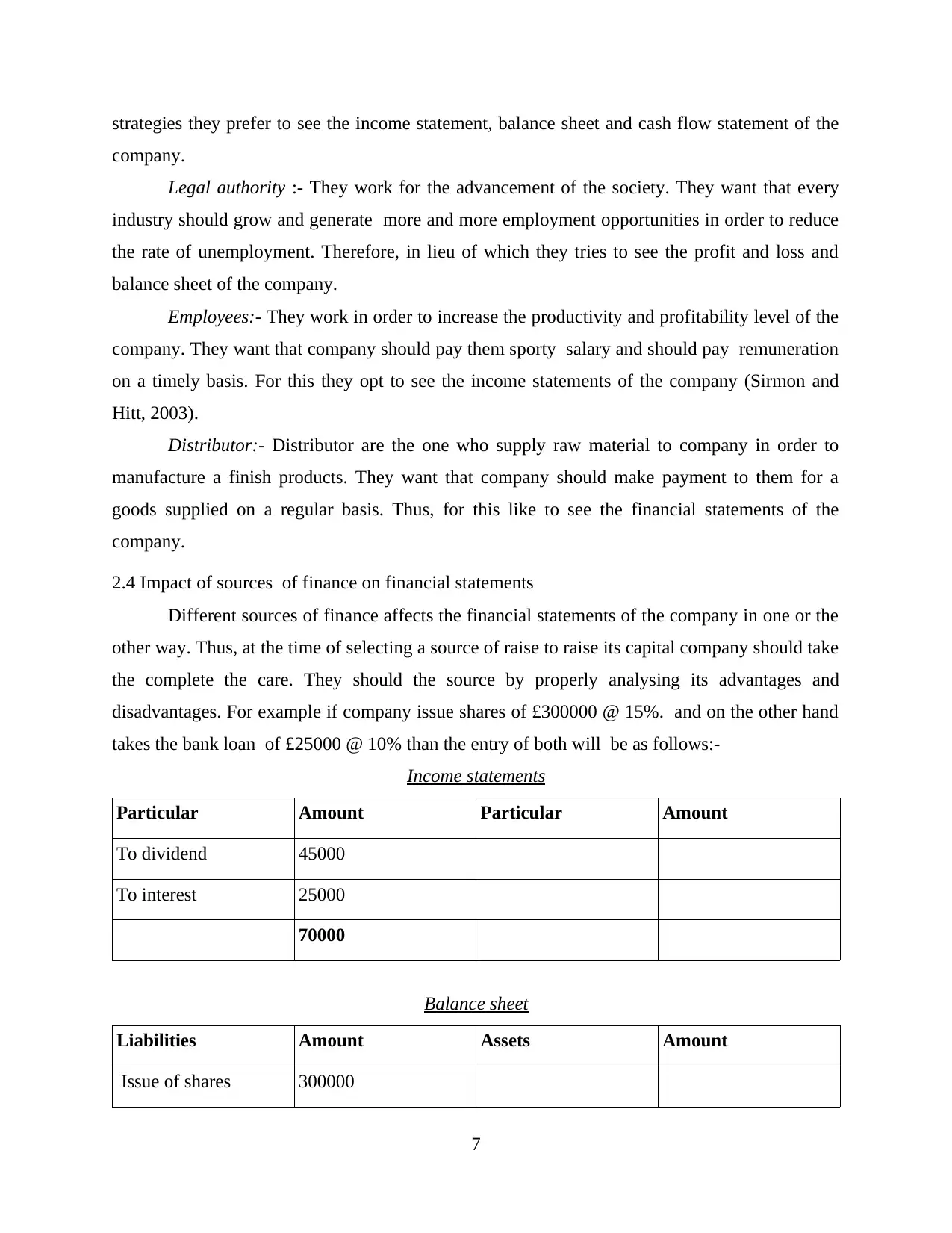
strategies they prefer to see the income statement, balance sheet and cash flow statement of the
company.
Legal authority :- They work for the advancement of the society. They want that every
industry should grow and generate more and more employment opportunities in order to reduce
the rate of unemployment. Therefore, in lieu of which they tries to see the profit and loss and
balance sheet of the company.
Employees:- They work in order to increase the productivity and profitability level of the
company. They want that company should pay them sporty salary and should pay remuneration
on a timely basis. For this they opt to see the income statements of the company (Sirmon and
Hitt, 2003).
Distributor:- Distributor are the one who supply raw material to company in order to
manufacture a finish products. They want that company should make payment to them for a
goods supplied on a regular basis. Thus, for this like to see the financial statements of the
company.
2.4 Impact of sources of finance on financial statements
Different sources of finance affects the financial statements of the company in one or the
other way. Thus, at the time of selecting a source of raise to raise its capital company should take
the complete the care. They should the source by properly analysing its advantages and
disadvantages. For example if company issue shares of £300000 @ 15%. and on the other hand
takes the bank loan of £25000 @ 10% than the entry of both will be as follows:-
Income statements
Particular Amount Particular Amount
To dividend 45000
To interest 25000
70000
Balance sheet
Liabilities Amount Assets Amount
Issue of shares 300000
7
company.
Legal authority :- They work for the advancement of the society. They want that every
industry should grow and generate more and more employment opportunities in order to reduce
the rate of unemployment. Therefore, in lieu of which they tries to see the profit and loss and
balance sheet of the company.
Employees:- They work in order to increase the productivity and profitability level of the
company. They want that company should pay them sporty salary and should pay remuneration
on a timely basis. For this they opt to see the income statements of the company (Sirmon and
Hitt, 2003).
Distributor:- Distributor are the one who supply raw material to company in order to
manufacture a finish products. They want that company should make payment to them for a
goods supplied on a regular basis. Thus, for this like to see the financial statements of the
company.
2.4 Impact of sources of finance on financial statements
Different sources of finance affects the financial statements of the company in one or the
other way. Thus, at the time of selecting a source of raise to raise its capital company should take
the complete the care. They should the source by properly analysing its advantages and
disadvantages. For example if company issue shares of £300000 @ 15%. and on the other hand
takes the bank loan of £25000 @ 10% than the entry of both will be as follows:-
Income statements
Particular Amount Particular Amount
To dividend 45000
To interest 25000
70000
Balance sheet
Liabilities Amount Assets Amount
Issue of shares 300000
7
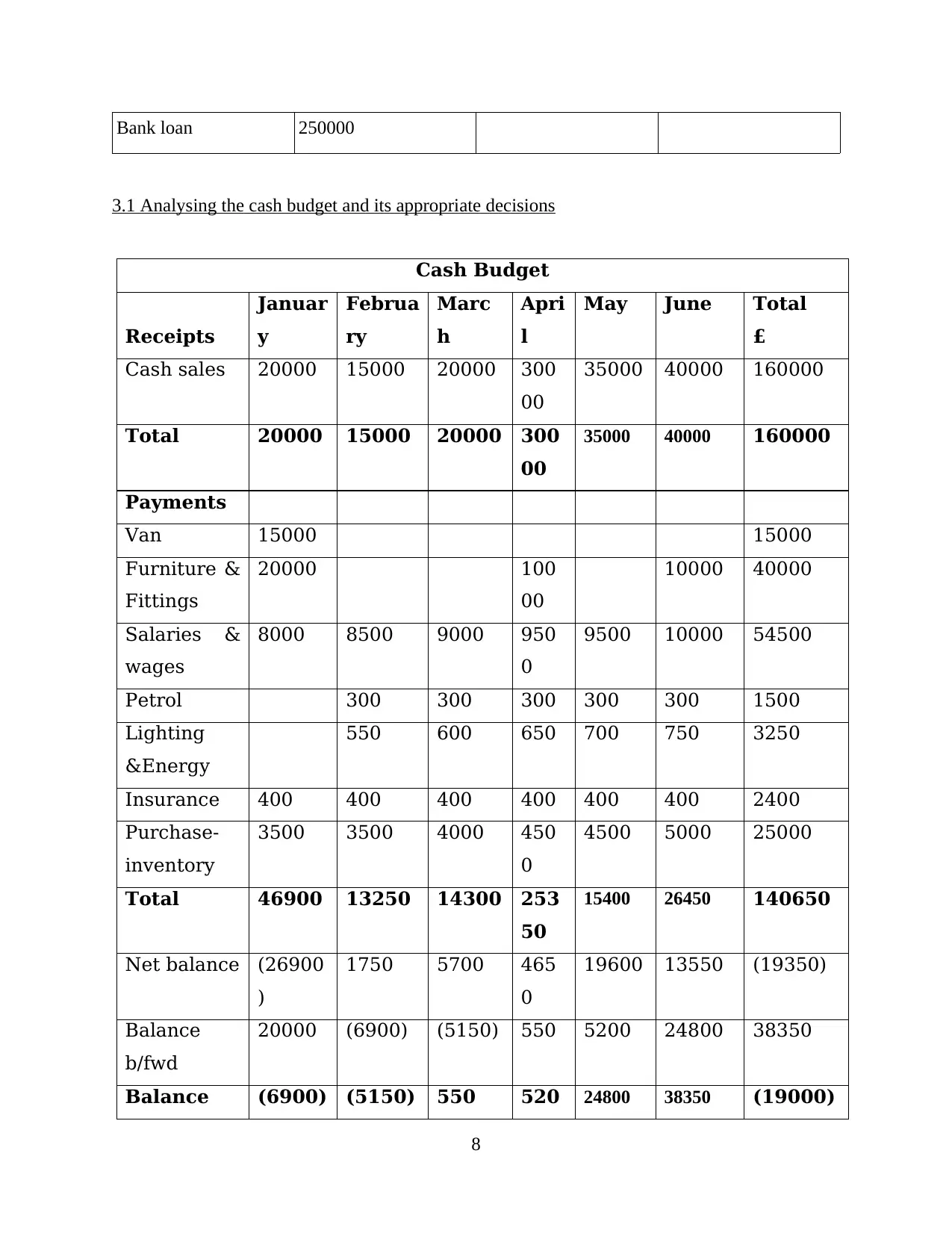
Bank loan 250000
3.1 Analysing the cash budget and its appropriate decisions
Cash Budget
Receipts
Januar
y
Februa
ry
Marc
h
Apri
l
May June Total
£
Cash sales 20000 15000 20000 300
00
35000 40000 160000
Total 20000 15000 20000 300
00
35000 40000 160000
Payments
Van 15000 15000
Furniture &
Fittings
20000 100
00
10000 40000
Salaries &
wages
8000 8500 9000 950
0
9500 10000 54500
Petrol 300 300 300 300 300 1500
Lighting
&Energy
550 600 650 700 750 3250
Insurance 400 400 400 400 400 400 2400
Purchase-
inventory
3500 3500 4000 450
0
4500 5000 25000
Total 46900 13250 14300 253
50
15400 26450 140650
Net balance (26900
)
1750 5700 465
0
19600 13550 (19350)
Balance
b/fwd
20000 (6900) (5150) 550 5200 24800 38350
Balance (6900) (5150) 550 520 24800 38350 (19000)
8
3.1 Analysing the cash budget and its appropriate decisions
Cash Budget
Receipts
Januar
y
Februa
ry
Marc
h
Apri
l
May June Total
£
Cash sales 20000 15000 20000 300
00
35000 40000 160000
Total 20000 15000 20000 300
00
35000 40000 160000
Payments
Van 15000 15000
Furniture &
Fittings
20000 100
00
10000 40000
Salaries &
wages
8000 8500 9000 950
0
9500 10000 54500
Petrol 300 300 300 300 300 1500
Lighting
&Energy
550 600 650 700 750 3250
Insurance 400 400 400 400 400 400 2400
Purchase-
inventory
3500 3500 4000 450
0
4500 5000 25000
Total 46900 13250 14300 253
50
15400 26450 140650
Net balance (26900
)
1750 5700 465
0
19600 13550 (19350)
Balance
b/fwd
20000 (6900) (5150) 550 5200 24800 38350
Balance (6900) (5150) 550 520 24800 38350 (19000)
8
⊘ This is a preview!⊘
Do you want full access?
Subscribe today to unlock all pages.

Trusted by 1+ million students worldwide
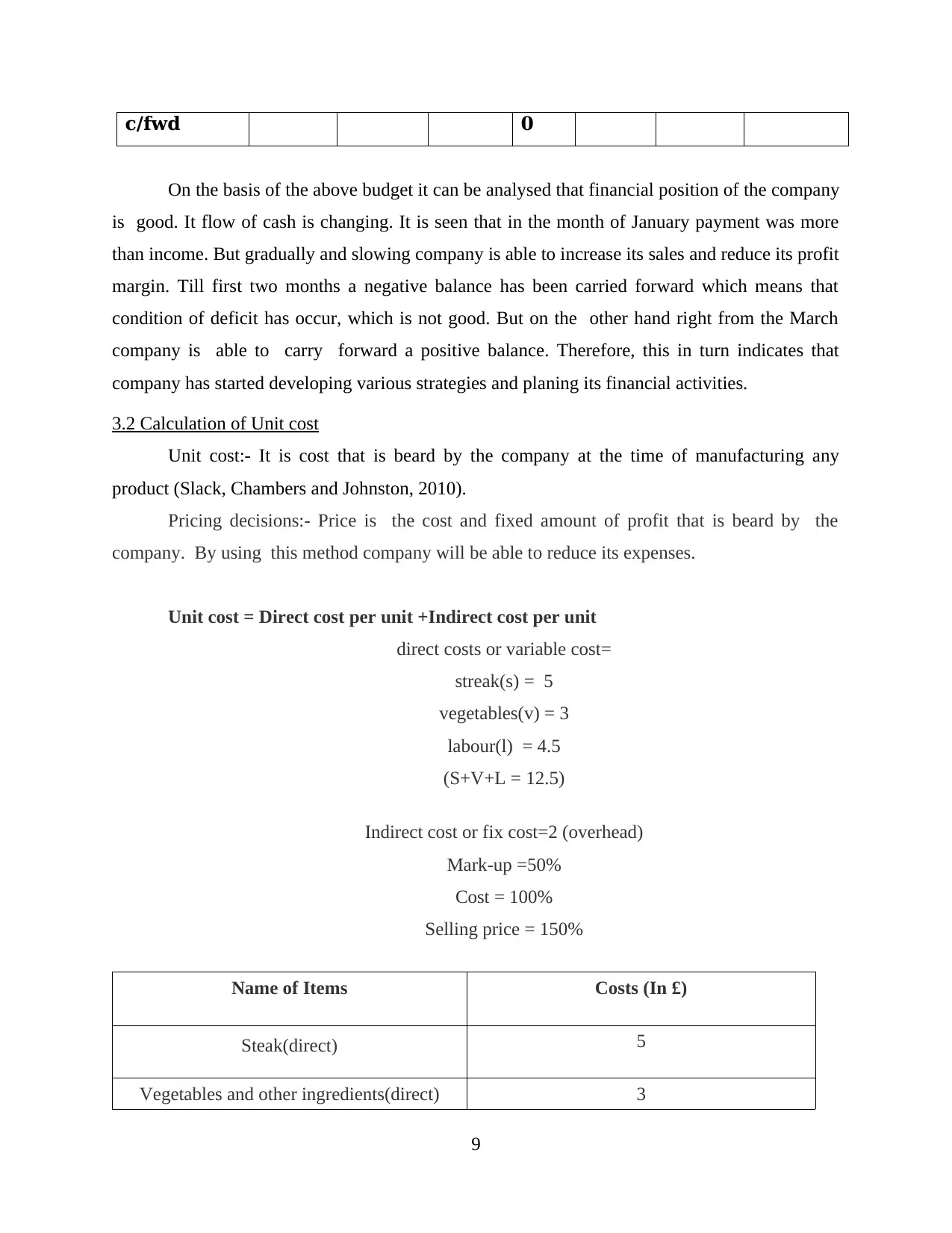
c/fwd 0
On the basis of the above budget it can be analysed that financial position of the company
is good. It flow of cash is changing. It is seen that in the month of January payment was more
than income. But gradually and slowing company is able to increase its sales and reduce its profit
margin. Till first two months a negative balance has been carried forward which means that
condition of deficit has occur, which is not good. But on the other hand right from the March
company is able to carry forward a positive balance. Therefore, this in turn indicates that
company has started developing various strategies and planing its financial activities.
3.2 Calculation of Unit cost
Unit cost:- It is cost that is beard by the company at the time of manufacturing any
product (Slack, Chambers and Johnston, 2010).
Pricing decisions:- Price is the cost and fixed amount of profit that is beard by the
company. By using this method company will be able to reduce its expenses.
Unit cost = Direct cost per unit +Indirect cost per unit
direct costs or variable cost=
streak(s) = 5
vegetables(v) = 3
labour(l) = 4.5
(S+V+L = 12.5)
Indirect cost or fix cost=2 (overhead)
Mark-up =50%
Cost = 100%
Selling price = 150%
Name of Items Costs (In £)
Steak(direct) 5
Vegetables and other ingredients(direct) 3
9
On the basis of the above budget it can be analysed that financial position of the company
is good. It flow of cash is changing. It is seen that in the month of January payment was more
than income. But gradually and slowing company is able to increase its sales and reduce its profit
margin. Till first two months a negative balance has been carried forward which means that
condition of deficit has occur, which is not good. But on the other hand right from the March
company is able to carry forward a positive balance. Therefore, this in turn indicates that
company has started developing various strategies and planing its financial activities.
3.2 Calculation of Unit cost
Unit cost:- It is cost that is beard by the company at the time of manufacturing any
product (Slack, Chambers and Johnston, 2010).
Pricing decisions:- Price is the cost and fixed amount of profit that is beard by the
company. By using this method company will be able to reduce its expenses.
Unit cost = Direct cost per unit +Indirect cost per unit
direct costs or variable cost=
streak(s) = 5
vegetables(v) = 3
labour(l) = 4.5
(S+V+L = 12.5)
Indirect cost or fix cost=2 (overhead)
Mark-up =50%
Cost = 100%
Selling price = 150%
Name of Items Costs (In £)
Steak(direct) 5
Vegetables and other ingredients(direct) 3
9
Paraphrase This Document
Need a fresh take? Get an instant paraphrase of this document with our AI Paraphraser
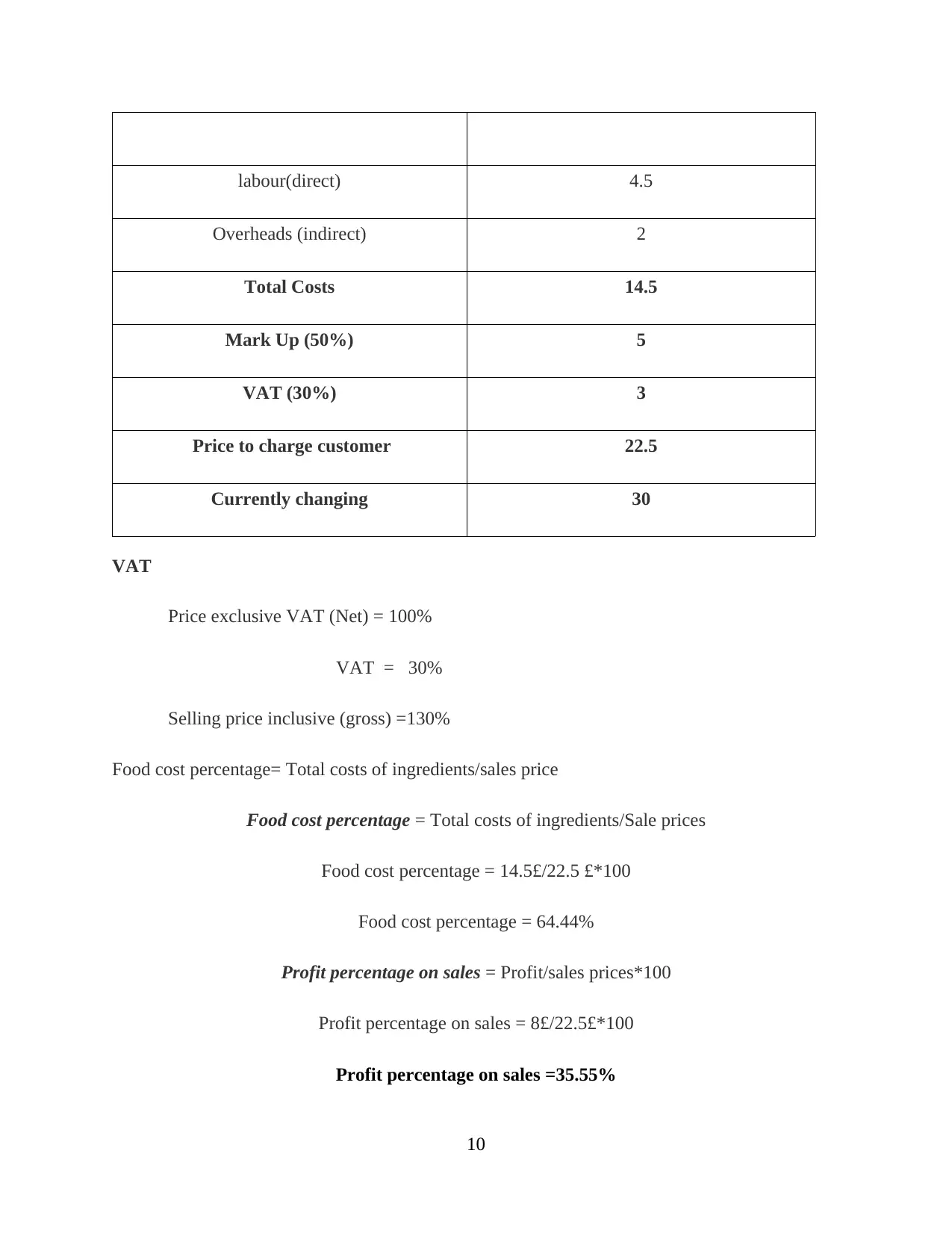
labour(direct) 4.5
Overheads (indirect) 2
Total Costs 14.5
Mark Up (50%) 5
VAT (30%) 3
Price to charge customer 22.5
Currently changing 30
VAT
Price exclusive VAT (Net) = 100%
VAT = 30%
Selling price inclusive (gross) =130%
Food cost percentage= Total costs of ingredients/sales price
Food cost percentage = Total costs of ingredients/Sale prices
Food cost percentage = 14.5£/22.5 £*100
Food cost percentage = 64.44%
Profit percentage on sales = Profit/sales prices*100
Profit percentage on sales = 8£/22.5£*100
Profit percentage on sales =35.55%
10
Overheads (indirect) 2
Total Costs 14.5
Mark Up (50%) 5
VAT (30%) 3
Price to charge customer 22.5
Currently changing 30
VAT
Price exclusive VAT (Net) = 100%
VAT = 30%
Selling price inclusive (gross) =130%
Food cost percentage= Total costs of ingredients/sales price
Food cost percentage = Total costs of ingredients/Sale prices
Food cost percentage = 14.5£/22.5 £*100
Food cost percentage = 64.44%
Profit percentage on sales = Profit/sales prices*100
Profit percentage on sales = 8£/22.5£*100
Profit percentage on sales =35.55%
10
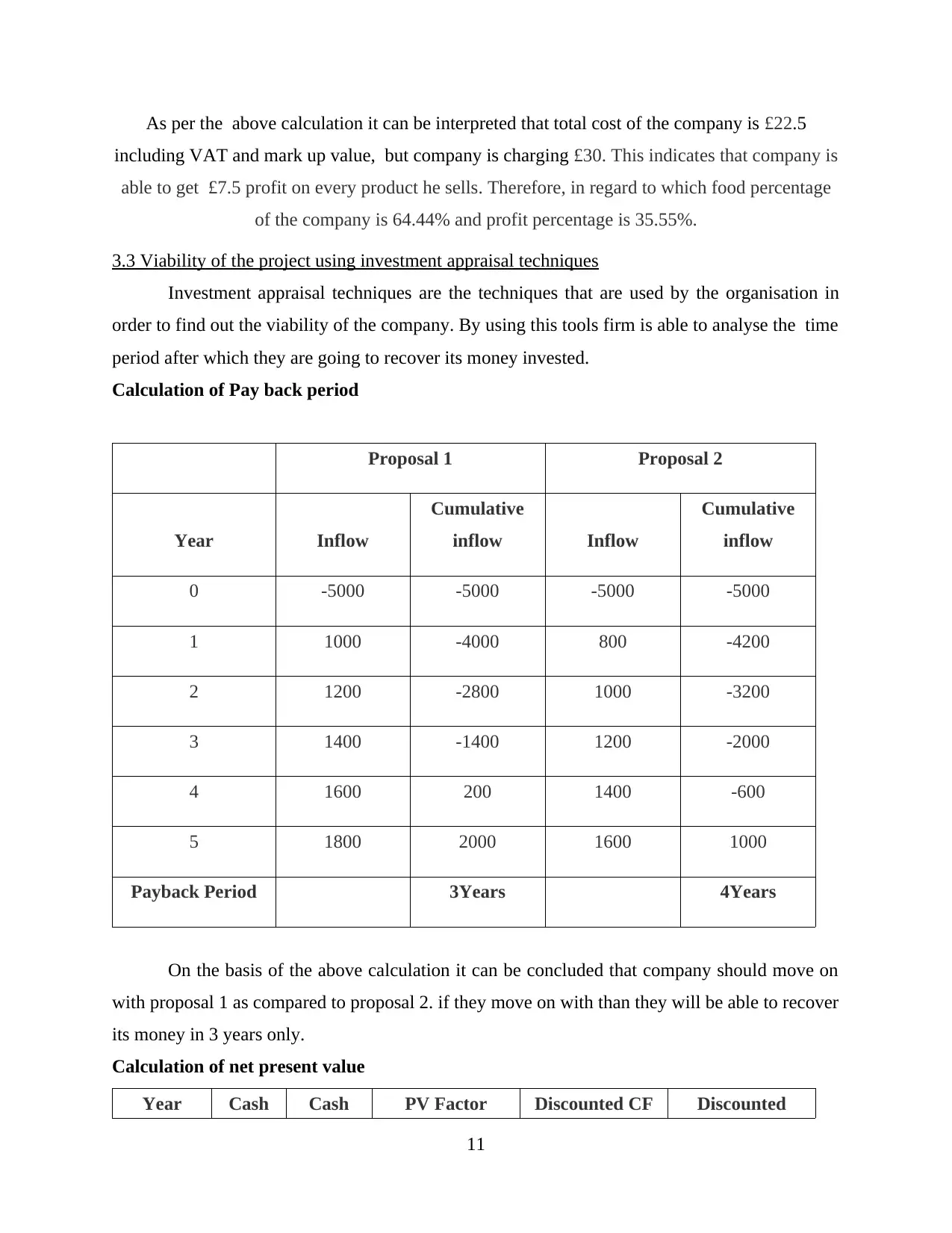
As per the above calculation it can be interpreted that total cost of the company is £22.5
including VAT and mark up value, but company is charging £30. This indicates that company is
able to get £7.5 profit on every product he sells. Therefore, in regard to which food percentage
of the company is 64.44% and profit percentage is 35.55%.
3.3 Viability of the project using investment appraisal techniques
Investment appraisal techniques are the techniques that are used by the organisation in
order to find out the viability of the company. By using this tools firm is able to analyse the time
period after which they are going to recover its money invested.
Calculation of Pay back period
Proposal 1 Proposal 2
Year Inflow
Cumulative
inflow Inflow
Cumulative
inflow
0 -5000 -5000 -5000 -5000
1 1000 -4000 800 -4200
2 1200 -2800 1000 -3200
3 1400 -1400 1200 -2000
4 1600 200 1400 -600
5 1800 2000 1600 1000
Payback Period 3Years 4Years
On the basis of the above calculation it can be concluded that company should move on
with proposal 1 as compared to proposal 2. if they move on with than they will be able to recover
its money in 3 years only.
Calculation of net present value
Year Cash Cash PV Factor Discounted CF Discounted
11
including VAT and mark up value, but company is charging £30. This indicates that company is
able to get £7.5 profit on every product he sells. Therefore, in regard to which food percentage
of the company is 64.44% and profit percentage is 35.55%.
3.3 Viability of the project using investment appraisal techniques
Investment appraisal techniques are the techniques that are used by the organisation in
order to find out the viability of the company. By using this tools firm is able to analyse the time
period after which they are going to recover its money invested.
Calculation of Pay back period
Proposal 1 Proposal 2
Year Inflow
Cumulative
inflow Inflow
Cumulative
inflow
0 -5000 -5000 -5000 -5000
1 1000 -4000 800 -4200
2 1200 -2800 1000 -3200
3 1400 -1400 1200 -2000
4 1600 200 1400 -600
5 1800 2000 1600 1000
Payback Period 3Years 4Years
On the basis of the above calculation it can be concluded that company should move on
with proposal 1 as compared to proposal 2. if they move on with than they will be able to recover
its money in 3 years only.
Calculation of net present value
Year Cash Cash PV Factor Discounted CF Discounted
11
⊘ This is a preview!⊘
Do you want full access?
Subscribe today to unlock all pages.

Trusted by 1+ million students worldwide
1 out of 18
Related Documents
Your All-in-One AI-Powered Toolkit for Academic Success.
+13062052269
info@desklib.com
Available 24*7 on WhatsApp / Email
![[object Object]](/_next/static/media/star-bottom.7253800d.svg)
Unlock your academic potential
Copyright © 2020–2025 A2Z Services. All Rights Reserved. Developed and managed by ZUCOL.





